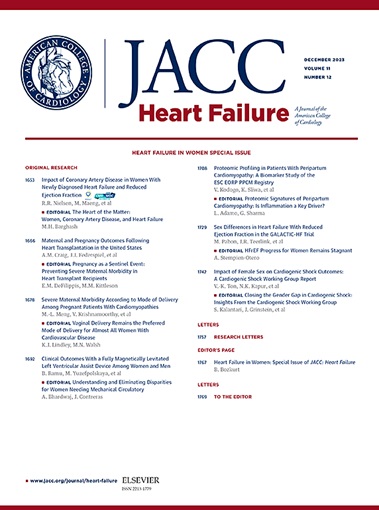Inferior Vena Cava Ultrasound to Guide Decongestion in Acute Decompensated Heart Failure
IF 11.8
1区 医学
Q1 CARDIAC & CARDIOVASCULAR SYSTEMS
引用次数: 0
Abstract
Background
Residual congestion at hospital discharge after an episode of acute decompensated heart failure (ADHF) is associated with poor prognosis. There is no consensus on how optimal decongestion should be assessed.
Objectives
This study aims to determine whether decongestive therapy guided by ultrasound measurements of inferior vena cava (IVC) diameters leads to greater reductions in N-terminal pro–B-type natriuretic peptide (NT-proBNP) levels from baseline to hospital discharge as compared with decongestion treatment guided by clinical assessment alone.
Methods
In a randomized controlled multicenter trial, patients admitted for ADHF (NYHA functional class ≥III) exhibiting signs of pulmonary congestion, peripheral edema, and NT-proBNP levels >300 ng/L were randomized to either decongestion therapy guided by daily IVC ultrasound plus clinical assessment or clinical assessment alone. The primary endpoint was the change in NT-proBNP levels from baseline to discharge.
Results
A total of 388 patients were randomized, of which 327 were included in the primary intention-to-treat analysis. The between-group difference in primary endpoint of change in NT-proBNP levels was 5.4% (95% CI: −9.4% to 22.6%; P = 0.58). Safety events were numerically less frequent in the IVC ultrasound–guided group. No difference between groups was consistently observed in secondary endpoints with similar rates of hemoconcentration and intensity of diuretic treatment.
Conclusions
Additional ultrasound evaluation of IVC diameters did not improve decongestion treatment compared with clinical assessment alone among patients admitted for ADHF. (Ultrasound Evaluation of the IVC in Addition to Clinical Assessment to Guide Decongestion in ADHF [CAVA-ADHF-DZHK10]; NCT03140566).
下腔静脉超声指导急性失代偿性心力衰竭的去充血
背景:急性失代偿性心力衰竭(ADHF)发作后出院时持续充血与不良预后相关。对于如何评估最佳的疏解拥堵,目前还没有达成共识。目的:本研究旨在确定超声测量下腔静脉(IVC)直径指导下的降血治疗是否比单纯临床评估指导下的降血治疗从基线到出院时导致n端前b型利钠肽(NT-proBNP)水平的更大降低。方法在一项随机对照多中心试验中,以ADHF (NYHA功能分级≥III级)为入院患者,表现为肺充血、外周水肿、NT-proBNP水平≤300 ng/L,随机分为每日IVC超声引导下的去充血治疗加临床评估和单独临床评估两组。主要终点是NT-proBNP水平从基线到出院的变化。结果共纳入388例患者,其中327例纳入主要意向治疗分析。NT-proBNP水平变化的主要终点组间差异为5.4% (95% CI: - 9.4%至22.6%;P = 0.58)。IVC超声引导组的安全事件发生率较低。在次要终点,在类似的血液浓度率和利尿剂治疗强度方面,两组之间没有一致的差异。结论在ADHF患者中,与单独进行临床评估相比,额外超声评估下腔静脉直径并不能改善去充血治疗。超声评估下腔静脉及临床评估指导ADHF减充血[CAVA-ADHF-DZHK10]; NCT03140566)。
本文章由计算机程序翻译,如有差异,请以英文原文为准。
求助全文
约1分钟内获得全文
求助全文
来源期刊

JACC. Heart failure
CARDIAC & CARDIOVASCULAR SYSTEMS-
CiteScore
21.20
自引率
2.30%
发文量
164
期刊介绍:
JACC: Heart Failure publishes crucial findings on the pathophysiology, diagnosis, treatment, and care of heart failure patients. The goal is to enhance understanding through timely scientific communication on disease, clinical trials, outcomes, and therapeutic advances. The Journal fosters interdisciplinary connections with neuroscience, pulmonary medicine, nephrology, electrophysiology, and surgery related to heart failure. It also covers articles on pharmacogenetics, biomarkers, and metabolomics.
 求助内容:
求助内容: 应助结果提醒方式:
应助结果提醒方式:


